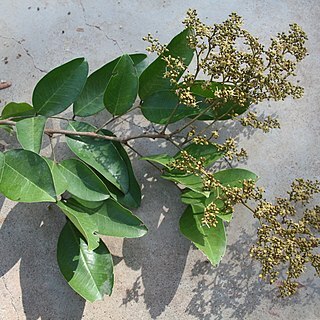Trees, occasionally shrubby. Stipules small, very early caducous. Leaves unifolio-late or imparipinnate, petiole and rachis without conspicuous glands. Leaflets generally alternate, margin entire. Inflorescences paniculate, terminal or axillary, often in fascicles; bracts not observed, bracteoles very early caducous. Flowers bisexual, zygomorphic. Hypanthium concave or narrow. Disc absent in Malesian species. Sepals 5 or 3. Petals usually none, sometimes (not in Malesia) 1,3, or 5. Stamens 2 or 6 (in Malesia); anthers basifixed, longitudinally dehiscent. Ovary sessile or shortly stipitate; style ± as long as the ovary; stigma small, punctiform to slightly swollen; ovules (1 or) 2. Pods indehiscent; exocarp usually brittle, sometimes firm; mesocarp pulpy. Seeds 1 (or 2), usually reniform, albuminous; testa smooth.
Unarmed trees, usually large. Leaves once-pinnate; leaflets few, moderately large, mostly alternate, coriaceous to submembranaceous; stipules caducous. In-florescence paniculate, axillary or terminal. Flowers small, caducous-bracteate; calyx 5 (rarely 4)-lobed, the lobes imbricate, the receptacular portion short, thick; petals 1-2 and minute, or lacking; stamens 2 or rarely 3, distinct, with short fila-ments; anthers oblong, basifixed, erect, dehiscent by slits; ovary sessile or sub-sessile, generally 2-ovulate; style short, with terminal stigma. Legume subglobose to ellipsoid, sparingly fleshy, indehiscent; seed usually 1, somewhat compressed.
Seeds either 1 or 2, often on the same plant, those in 2-seeded fruits differing markedly in shape from those in 1-seeded fruits, the testa smooth and shiny, without areoles.
Leaves imparipinnate (sometimes 3-foliolate), with leaflets opposite or alternate, often with a rather dense vein reticulum; stipules inconspicuous, lateral, caducous.
Fruit ellipsoid to ± spherical, sometimes laterally compressed, indehiscent; exocarp hard and brittle, the mesocarp pulpy and brown to orange or red when dry, edible.
Flowers small, in many-flowered terminal and lateral panicles; bracts and bracteoles small, caducous.
Flowers hermaphrodite, usually somewhat zygomorphic, with a well-developed disk.
Ovary sessile or shortly stipitate, often oblique, with 2 ovules.
Stamens 2_10; anthers basifixed, dehiscing by longitudinal slits.
Trees or rarely shrubs, unarmed, evergreen or deciduous.
Sepals normally 5, rarely 6 or 7, imbricate.
Petals greatly reduced or lacking.

